Tags
Related Posts
Share This
California Superbike School
Here it is at last. My write up about Superbike School, long awaited by some of you (you know who you are). :P

THE STORY SO FAR
Some of you might recall that I was signed up to do the two day camp of California Superbike School last June, but I did the idiot thing and signed up for a NESBA trackday weekend at Pacific Raceways in early June, just so that I would have a bit of track experience that year before I went out to learn from the pros. As it turns out, I crashed in the last five minutes of the first day partly because a control rider cut me off and mostly because I target fixated, did the squidly thing, panicked, gave in to my survival reaction, used up my $10 of survival time, whatever you want to call it. I went down with the bike on me, still holding on to the handlebars because I’d never learned how to crash, and ended up with a broken finger, two torn ligaments, a busted right knee and a badly bruised shin. Two surgeries fixed the finger and the ulnar collateral ligament (UCL), staying off of the leg helped heal the lateral collateral ligament (LCL), months of physiotherapy helped heal some of the scars, but I still have the busted knee and what they say is permanent nerve damage to my shin. Needless to say, I couldn’t do the school last year and had to cancel my spot, because the surgeons looked at me like I was mad when I asked them what dates I could sign up for that year. “You’re going to get back on that death machine again?”
And as a corollary, a couple of months after my surgeries, while I still had splints on both hands, I crashed my car when I failed to yield at a green light and turned left in front of an oncoming car – that old classic that kills thousands of my kind every year, now I had upon my head.
Last year is long gone, it’ll be almost a year since the day I first crashed, but while time has cured some of the physical injuries, my mental trauma refused to go away no matter what I tried. I’ve never talked or written about it much, because bikers aren’t supposed to be afraid, or if they are, nobody talks about it. If you’re scared, just park the fucking bike and walk, right? And for a while there, I even wondered to myself… why not? Park it, and you’ll be free of it. Maybe then all the nightmare scenarios that go on in your head every time you ride will finally go away. There’s other things you could do to find meaning in your life, like collect newts or something. People do it all the time.
For most of this year, all the riding plans I’d made have been less than half-hearted. I made them because they were things I was meant to do last year, but never got to do. Everything that I planned was more because I wanted to make up for the year I had lost rather than it being driven by any real desire or motivation. Even Superbike School I signed up for partly because I was meant to do it last year.
SUPERBIKE SCHOOL
So after that long introduction, let’s dive in to the school itself and what has passed in the past week. For those not in the know, California Superbike School is the premier rider instruction school in the US, Europe and Australia, started by Keith Code – former racer and the “best known motorcycle instructor in the world”. They hold one and two day rider camps on various racetracks around the world. The instruction goes from levels I through IV, and there are separate camps dedicated to racers. The training is done on that year’s Kawasaki ZX-6Rs.
I signed up in early April for Levels I and II at the Streets of Willow Springs track in southern California because I wanted to do the camp early on in the year and not have to fly too far out. Through most of April, I never actually thought too much about the school, although I did find time to get my leathers altered, and ordered back and chest protectors (custom made by Acme Motowear). In fact, not until the day before I was supposed to fly out did the full implication of what I was in for strike me and hit home.
I also occasionally went on the forums and plagued Cobie Fair with questions. He was nice enough to answer them all in time, re-assure me on all my doubts and qualms, and provide me with lots of great info.
STREETS OF WILLOW SPRINGS
The Streets of Willow Springs racetrack is perfect for a school. I thought it was very safe compared to Washington’s Pacific Raceways, with lots of runoff areas and no solid walls, but exciting with its long straights, couple of off-camber turns, a chicane and some esses.
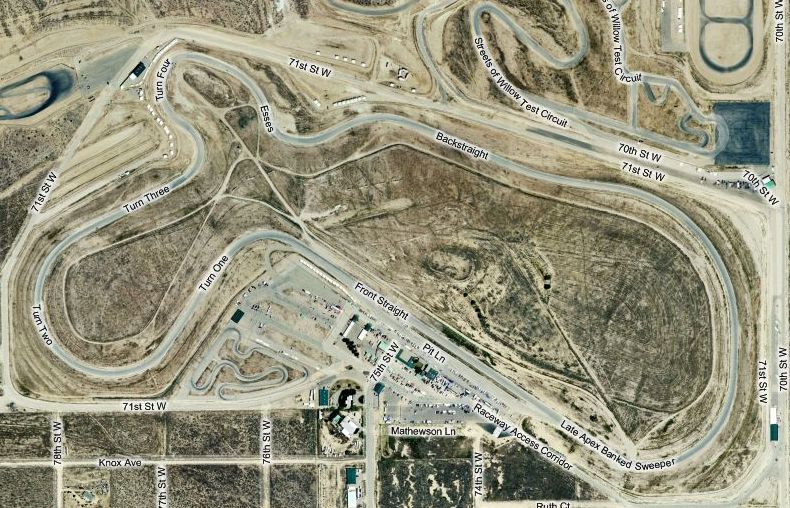
DAY 0: April 23rd, 2008
My class was scheduled for April 24th and 25th – a Thursday and Friday. I flew to Burbank, CA on the 23rd, picked up my rental car at Advantage Rent-A-Car and drove about 60 miles north to Lancaster, CA – a town I was advised to stay in by the school, as the closest town Rosamund, didn’t have much by way of food, or indeed civilization, being way out in the desert as it was. The drive up was rough and unpleasant because the freeways – both I-5 and 14 – were in shockingly bad condition. This was very surprising to me, because I assumed that the state of California would likely have much more money than Washington, but even the remotest roads in Washington that I’ve ridden on, have been in much better condition than interstate I-5 was down there. About an hour’s drive later (hooray for consistent 80mph driving speeds), I reached Lancaster and checked into the Motel 6 where I had my reservation. It was dismal, spartan (no fridge/wireless), noisy (people talking outside my room at all times of night, and walking overhead at two in the morning), but it was clean and cheap ($42/night), so I could hardly complain. My back protector had arrived at the hotel, and I tried it on, and found that it fit pretty well under the jacket.
I found a terrible “Japanese” restaurant that apparently served nothing but tempura, ate a crappy dinner, bought some water, and then turned in early, as we had to report to the track at 7:00AM.
DAY 1: April 24th, 2008
I had set at least three alarms, but I still kept waking up once every hour to check the time, and then fade back to sleep, until I finally got out of bed at 5:30AM, took a quick shower, and drove off to the track, which was about 11 miles away.
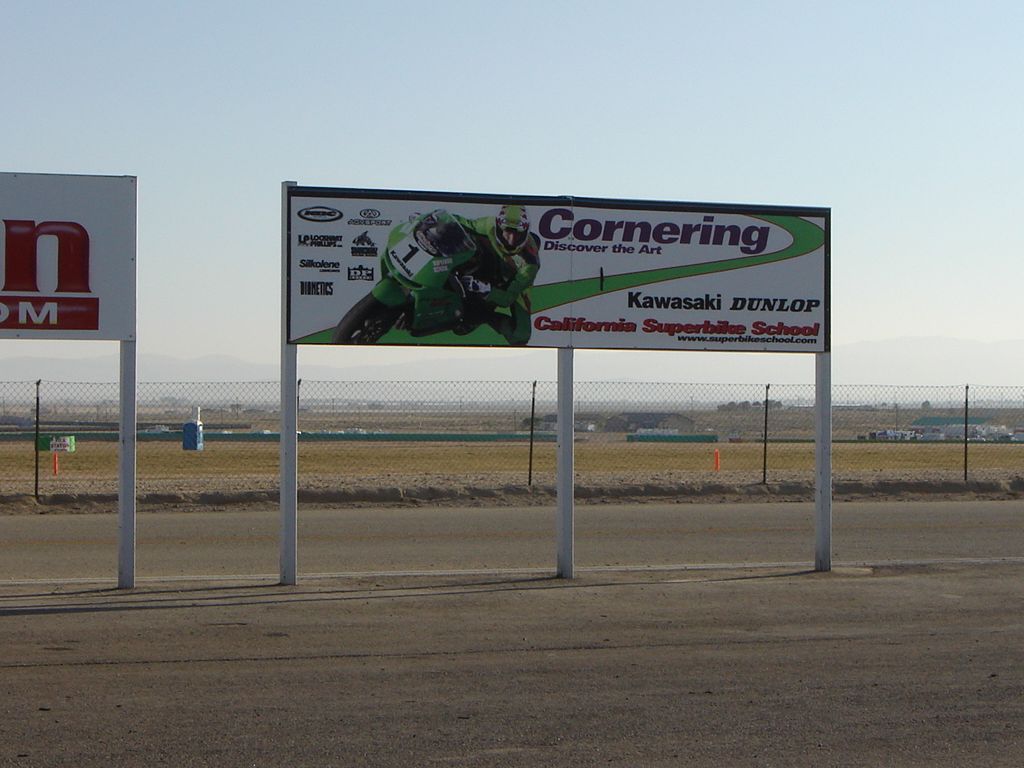
I arrived a little before 7:00AM. Some students had already driven up, and the CSS guys had just begun setting up. The bikes were all lined up and ready to go. It was a bit chilly out in the desert. Most of us were in our civvies and shivering a little. I thought California was supposed to be hot and sunny!
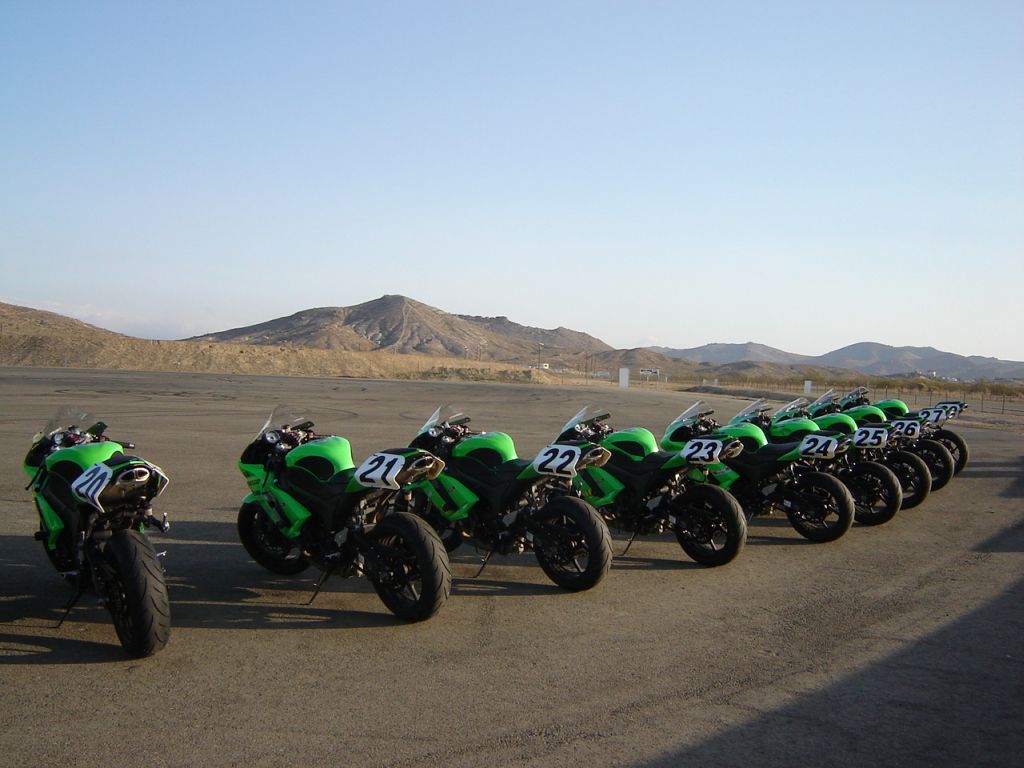
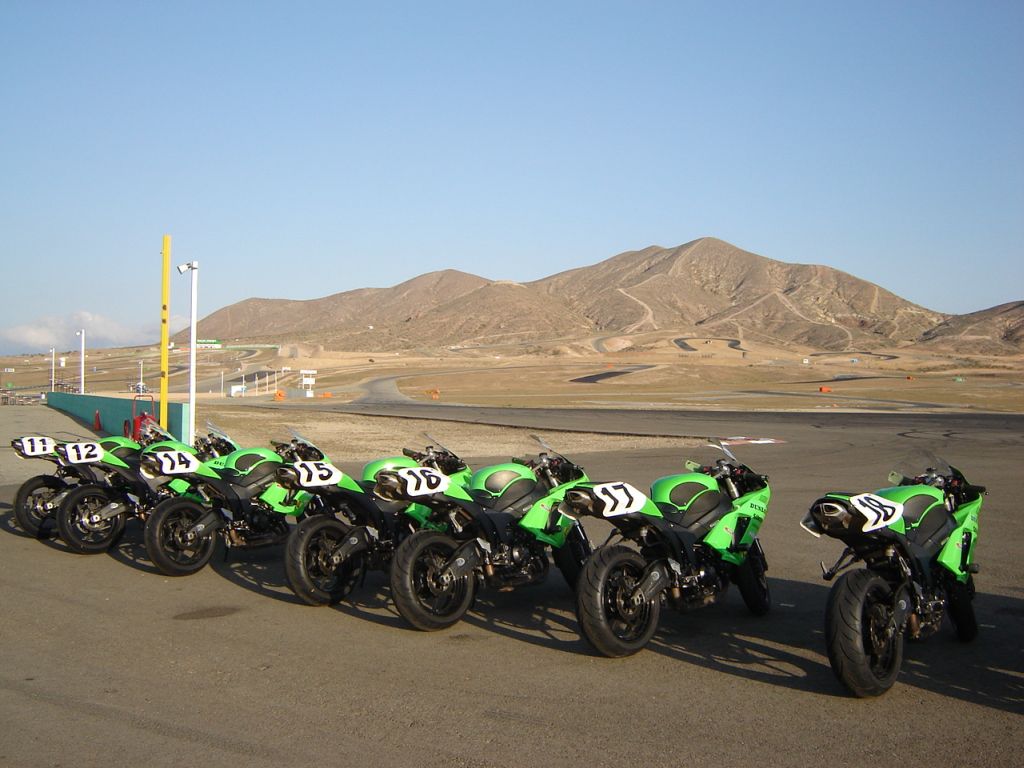
Breakfast was being prepared and served, which I promptly helped myself to. One benefit of signing up to a camp is the catered breakfasts and lunches and food/snacks being provided all day long. The food was all good and healthy. For breakfast, there was toast, bagels, eggs, sausages, cereal, fruit, juice, coffee – something for everyone.
We ate and were then called in for the first technical briefing of the day, where Keith Code introduced himself and his crew – his wife, Judy Code who took care of all the rider announcements, merchandise, food etc., Dylan – his son and a riding coach, Will – the mechanic, Cobie – chief riding coach, Trevor – track control, and all the riding coaches that students would be working with that day. He talked about the format of the camp, what we could expect for the next couple of days, rules and restrictions etc. We were advised to keep drinking water throughout the day, and pop salt and potassium tablets after every session to keep from getting dehydrated and make up for depleting electrolytes from all the sweating we would do in our leathers in the hot desert sun. They explained the flag color codes, which I think most of us knew from past trackdays anyway, although I wasn’t familiar with the blue flag until then.

We were divided up into two groups – White and Yellow, which would be alternating for track time through out the day. White group would be on for 20 minutes, then get back in to talk to their coach for a few minutes, a technical briefing, then get ready to go out again. While they were off track, the yellow group would be on the track. Most of the bikes would thus be in continuous use – one bike for every two students. They put sticky tape on our boots to mark our groups – I was in Yellow.
The majority of the students were much older guys, not that surprising considering the cost of the camp. There were only about 3-4 guys who were my age or younger. I was the only woman (big shocker).
The ratio of coach to students was 1:2 in each group, ensuring that every student got plenty of time and personal instruction from their assigned coach. My coach turned out to be a guy called Steve, who turned out to be super-nice and very effective (I later found out that his day job was a lieutenant in a SWAT unit).
They handed out leathers, boots, gloves and helmet to those who hadn’t brought their own gear. I found out that all their leathers were men’s suits (but of course!) and opted to wear all my own gear. We were also assigned the bike we would be riding for the duration of the camp. I was on bike 26 – the only one with a lowered suspension and seat. The bikes were parked in the off-track training area – a large open space for practicing slow speed maneuvers, and riding the special bikes like the brake and slide bikes.
The first drill was off-track and involved just riding around at slow speed and doing some turns and weaves to let the coach assess your abilities. I can confidently say that I was the absolute worst of the lot because all my fears about riding the ZX-6R came together in a blindingly panic-ridden moment.
I’d had my doubts about riding the ZX-6R for a long time seeing as it was a much taller bike than I was used to – even the lowered one I could barely tippy-toe, and the aggressive seating position with the tucked down stance was completely different from what I was used to. Not to mention that this was not my bike and I’ve always had a slight terror of riding a bike that didn’t belong to me. Also, just knowing me, I know that it takes me at least a few hours of practice before I get used to a new bike, and here I was, expected to just get on and go. :|
I stalled the bike at least once, got on and rode a short distance in an embarrassingly wobbly way, was stiff as a board and clamping down on the handlebars, with a deer in the headlights look in my eyes, and completely mortified about all the people watching me act like a complete tool. I think my coach deserves a medal for being so patient with me during that exercise. He asked me how long I had been riding, and when I said three years, he told me to just calm down and told me I would be okay. Although after I finally parked the bike and went to the rest area to wait for the Yellow group to be called out, I half-expected someone to come over to me, hand me the money I paid for the class, and send me home.
Keith and Will did come up and suggested that I do more off-track work because they were concerned about how I’d do on the track after watching me off-track. I told them I wanted to go out because I’d be okay at higher speeds. And no, this wasn’t even the lowest point of my day by far. I should get points for not throwing my helmet on the ground and bawling like a three year old, right?
When we were called out, I got on again, made it to the start-finish area, got in line with the others, where Trevor- the course control guy – also asked me how long I had been riding. I glared at him and asked if he asked everybody that, and he grinned ruefully and said, “No, only people that I like.” Ha! (Incidentally, that was a question I got asked a LOT that first day, probably because my dismal performance made people wonder if I’d even ridden a pushbike in all my life.)
DAY 1: DRILL 1: THROTTLE CONTROL: The first on-track drill was Throttle Control and the format was fourth gear, no brakes. We were instructed to negotiate the entire track in fourth gear only and not use any brakes (unless it were a dire necessity) and practice constant, smooth, throttle control. Easy peasy, right? Wrong. I still found the bike completely awkward, was still stiff as a board, was completely thrown by the track (of course I hadn’t had the foresight to STUDY the track in advance) and rode painfully slow. My back hurt, as did my wrists, and I barely made it through all the laps.
Came back in, wondering what the HELL I was doing there, why the HELL had I listened to people who said that I was ready for the school, why the HELL did I not listen to my instincts that those bikes would be the bane of me, why the HELL did I not bring my own bike so I could show the disbelievers that I COULD FUCKING RIDE, thank you very much, and other thoughts of such nature. This time round I was expecting someone to stroll over to me and tell me that my endorsement had been revoked and that I wasn’t ever allowed anywhere near a two wheeler again.
DAY 1: DRILL 2: TURN POINTS: This drill was going round the track again in 3rd and 4th gear, no brakes, only this time the turn points that we would take were marked on the track with big yellow crosses, as guideline. So basically, ride in to the turn, lean the bike over on the turn points, open gas, and maintain a steady throttle throughout the turn. I have to say that the yellow crosses were a major breakthrough, and finally added a method to the madness of us just diving into a turn, turning any which way and making our way out based on our instincts. The turnpoints were placed in spots that allowed us to make the turn such that it didn’t require any further steering adjustment and we didn’t run wide in the turn.
I was a bit more organized this time as the number of unknowns had decreased drastically. I still missed a few – as did many other riders that were ahead of me. The ones I missed were mainly because they were so close to the edge of the track and out of my line of sight due to elevation changes, that I was afraid of running off. And indeed, a couple of guys did run off onto the dirt area.
DAY 1: DRILL 3: QUICK TURNING: Ride up to the turn, slow down as much as needed, push on handlebar hard to lean in for a quick turn.
I completely botched this drill because I was still overwhelmed by the bike and circuit, and I was still hanging on to the handlebars, making any kind of turn rather hard.
DAY 1: LUNCH BREAK : Lunch was good – we made out own sandwiches and there was pasta, salad, and fruit. I took my plate over to one of the tables, sat down awkwardly with my undone jacket hanging from my waist and promptly went down as the bar stool slipped under me. No damage done though. Thank heavens for leathers. :P
*general cries of alarm*
Random people: “Are you okay?”
Me: “Only my pride.”
One of the guys helped me up, as I clambered up red-faced, laughing my head off at the idiocy of the situation, and everyone grinned back. I think this was the point when more people started coming up to me talk. I am naturally reticent in bigger groups, and it takes a bit of time for the ice to break before I can bring myself to talk to anyone. It doesn’t help that a lot of people seem to find my intimidating – even those that are twice my size – so overall it’s a bad combination for any initial group camaraderie.
The guy who helped me up – Jack – apologized to me for passing too close at some point in the track which I had no memory of. He was about twice my age – apparently he’d been riding since 1965 – and seemed nice enough, so I sat with him to eat lunch, and we chatted a bit about bikes and track days and such.
I talked with another guy who had flown in from Kuwait for Levels III and IV, and he told me to not worry about going fast and just concentrate on learning all the techniques. He said that a lot of the guys were going super-fast without really thinking, and tiring themselves out and not learning as much as they could have been. I took his advice to heart and felt a little less stressed about being so slow.
DAY 1: DRILL 4: RIDER INPUT: Three gears, light braking. Quit being stiff on the bike, because it will respond to your every movement. Easier said than done in my case. :P
DAY 1: DRILL 5: TWO STEP: In the technical briefing for this one, we were asked if we had been target fixating on the turn points, and we almost universally nodded. This time round we were instructed to use the turn point as a guideline, and as soon as we knew that we were going to make it, look away towards the next turn and lean the bike over.
This was a great drill and we all came back happy, reporting that it had been a major breakthrough.
DAY 1: EPILOGUE At the end of Day 1, I was sore, bone-tired and felt lower than a rat’s navel. I managed to drag myself back to Lancaster, got some coffee and thought dully of the horror that the past day had been, and wondering how I could have ever thought that I was a good rider. I also reflected that everything that had been taught until then had been no-brainers, things that I already kinda knew, and had been worth paying that much to even take the school.
A shitty dinner later, I went back to the motel, brought out a laptop and made some notes about the day and things to improve on, before falling asleep at 9:00PM. This night I slept like a baby.
DAY2: APRIL 25TH, 2008
DAY 2: DRILL 1: REFERENCE POINTS: In this one, Keith went over photographs of the track on a screen and pointed out how much stuff (scar on the road, house in the distance, mountain peak etc.) we could use as reference points for braking/rolling on/off etc. He said to pick reference points for each turn and keep them constant.
I had been doing this somewhat because I always keep my vision high and on the horizon in my turns, but this was an added level of clarity. I think I did well here.
Everybody agreed that this was a good run, and indeed my first session out was incredibly good. This time I was not hesitating because I knew the track well now and was more comfortable on the bike. I concentrated on practicing everything from the past day. My coach pulled me over once and pointed out a few thing – I did not have to slow down significantly as I approached the chicane at the end of the back straight. He said that I was practically parking the bike there, when I could just go at the same speed, right over the striped yellow bump and then slow down a bit for the next turn. He also said that he noticed that I kept making tiny throttle adjustments through the turn in the long sweepers, which were completely unnecessary, and I should just try to make one clean turn, rolling on the throttle gradually and holding it.
I paid attention to his advice and made some improvements, at least for some of the turns. I was also doing a lot better on the esses since we had been told the previous day that the best riders under the best conditions couldn’t make them at over 24 mph, so I wasn’t stressing over being fast there anymore, just concentrating on hitting the turn points, and making all the tight turns.
DAY 2: DRILL 2: CHANGE LINES: For this drill, we were instructed to do the first lap on the left edge of the track, the second one on the right edge, and the third one down the middle, all at slow speeds, with the aim of really learning how big the track was, and how it was okay to not make your line and pick a new one because there was more room there than we thought there was.
This one was a drill that we all loved.
DAY 2: DRILL 3: VANISHING POINTS: Two gears, very light braking. Look for examples of vanishing points on the track. Try and eliminate any negative effects they may have on your riding.
In this drill, I was called upon to ride the camera bike, which is a bike set up with a video camera and films you through two laps. While I had been doing pretty good until then, I made a complete arse of myself here. First it took me about five minutes to get going on the bike because it was so tall that even though the guys had a hold of it, I didn’t trust myself enough to not put my feet down and just go. I finally took off and completely botched most of the turns in the first lap because of that feeling of Being. Watched. The second lap was a bit better, but not by very much.
DAY 2: LUNCH BREAK
Lunch was the same as the previous day, except that it tasted like ashes in my mouth what with the mortification of getting to watch the filmed video, cringing through it all, and slinking away when it was done.
It didn’t help that Jack came up to me and told him about how he had been high-fived about two excellent passes he did when he was on the video bike. Arrghhh…. go away, old man!
DAY 2: DRILL 4: WIDE VIEW: This time we were briefed to avoid tunnel vision and have a “wide view”. Fixating in one place leads to things coming at you too quickly and not giving you enough time to react. Opening up your view to a bigger vista instead helped you realize that the track was a plenty big place and there was plenty of room to go even if you came in to a turn too hot.
This helped. A lot.
DAY 2: DRILL 5: PICK UP: This was taking the Two Step a little further – go up to the turn, qiuck turn, lean in and roll on throttle, then “pick up” the bike, to straighten it out just a little sooner than we were doing before.
I did one off-track session here with Hymey (?). Since I couldn’t ride the slide bike, we did some sessions on my regular bike. He corrected my seating position, telling me to move back from the tank, and really grip it with my knees. Then he made me do some steering exercises with really loose arms, leaning in to each turn as I did it. Oddly enough, this was my biggest breakthrough in the entire two days, and I dearly wished we had done it the previous day. Apparently I wasn’t counter steering correctly. While I was pushing the handlebar to make the bike turn, since my other hand was clamped onto the bar, I was forcing the bike to also lean the other way without realizing it.
When I went out on the track next, my arms were super loose, I wasn’t hanging on to the bike anymore, and just loosely gripping with each hand, just enough to operate the controls. Everything just came together this point onward and I flew through the laps. I wasn’t tired anymore, my back didn’t hurt, I wasn’t afraid of the turns, I leaned way over, I made all the turn points, I had near-perfect throttle control, and of course the photographers had stopped photographing for the day, and I wasn’t on the video bike.
DAY 2: PRACTICE SESSIONS: I went on the brake bike with Hymey instructing again. This was Kawasaki that was a near replica of my SV and I found it super easy to ride. I was told to get up to about 30 mph and then snap the front brake until it locked. I tried this a few times, but was unable to lock it. In fact, I found my MSF training kicking in unconsciously, and every panic stop I made, I braked with both brakes and shifted down gears without even realizing it. Oh well…
The rest of my track time was the stuff that dreams are made of. I flew through the track and everything was right and perfect. I even shifted my weight off of the bike and hung off for some of the turns – something I have never done on the SV. Valentino Rossi once said that he riding his bike was like dancing with a beautiful woman. I know exactly what he meant because it really did feel like I were dancing with the bike, with me in the lead, while she followed and responded to my every cue. I think that for those last few sessions I was in pure motorcycling zen. All of a sudden, I was ecstatic and the tension and stress of the past few days fell away like they had never happened.
Every time I walked back into the pits, I felt like I was walking on a foot of air. Many riders came up to me to tell me that I was doing incredibly well. Jack mentioned that if they did a recap of which people improved the most in the school, I’d probably be top of the list. A back-handed compliment perhaps, but a fair one, considering my performance for the past day.
DAY 2: EPILOGUE:
When it was all over, my instructor was all grins and said that he knew I would make it. I hugged him and thanked him for having faith in me.
The day came to a close all too quickly. All too soon, it was time for debriefing and handing out of graduation certificates. Keith said a few last words, we took some photos, got some goodie bags, said our goodbyes and it was time to go home.
*sigh*
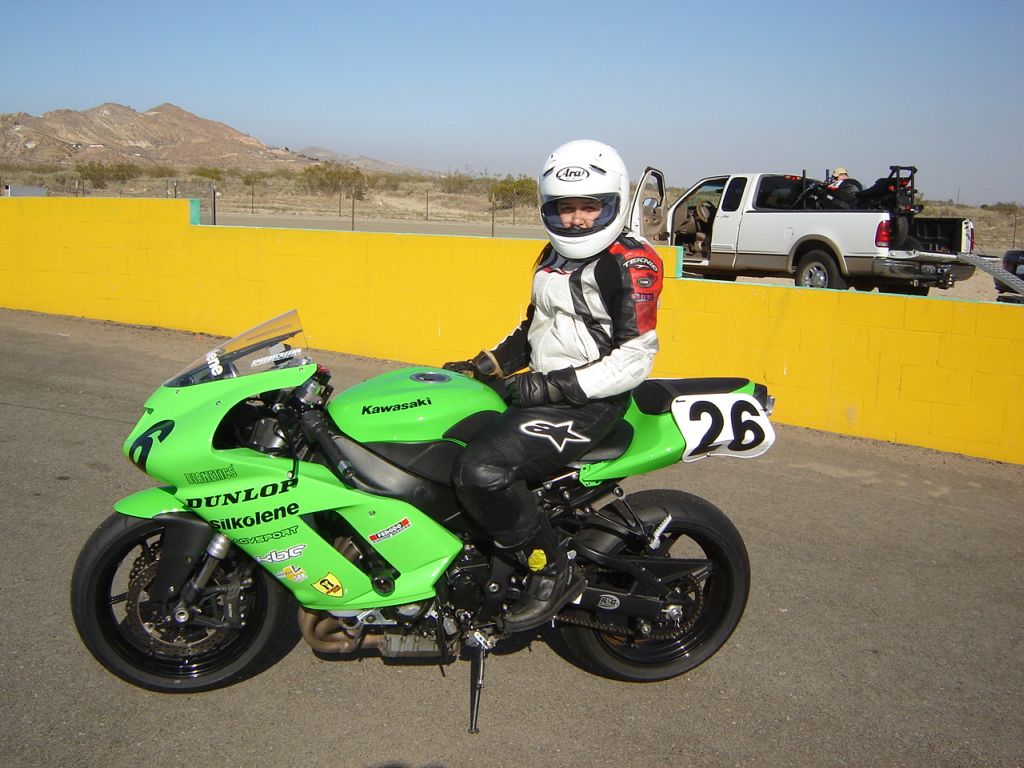
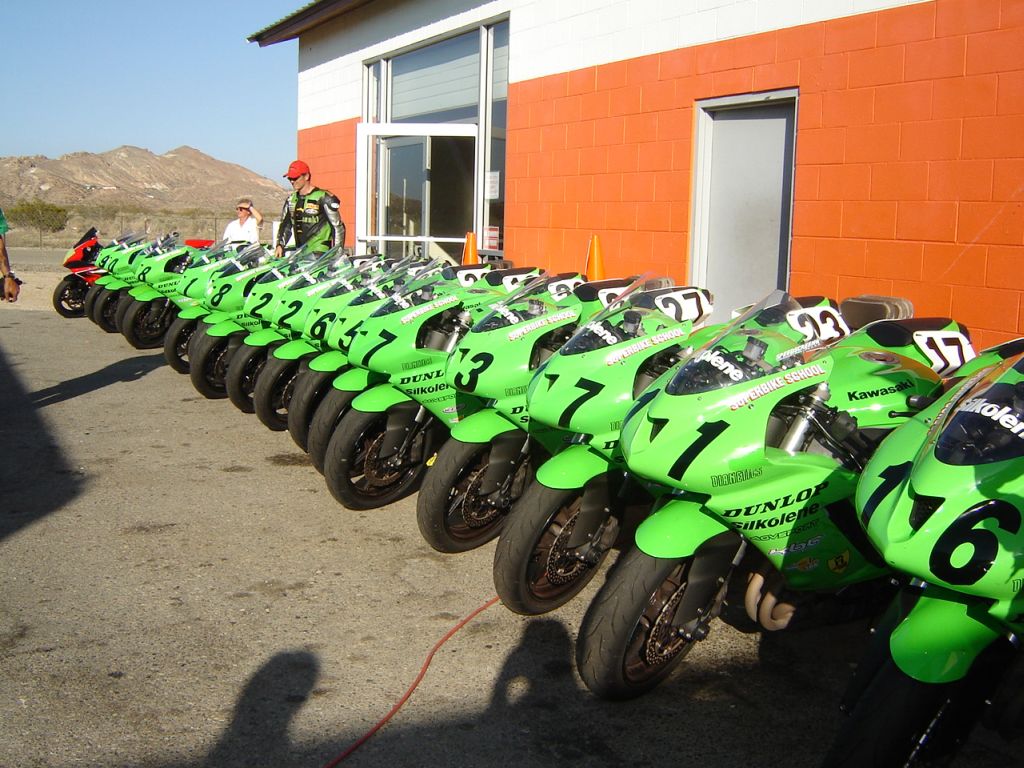
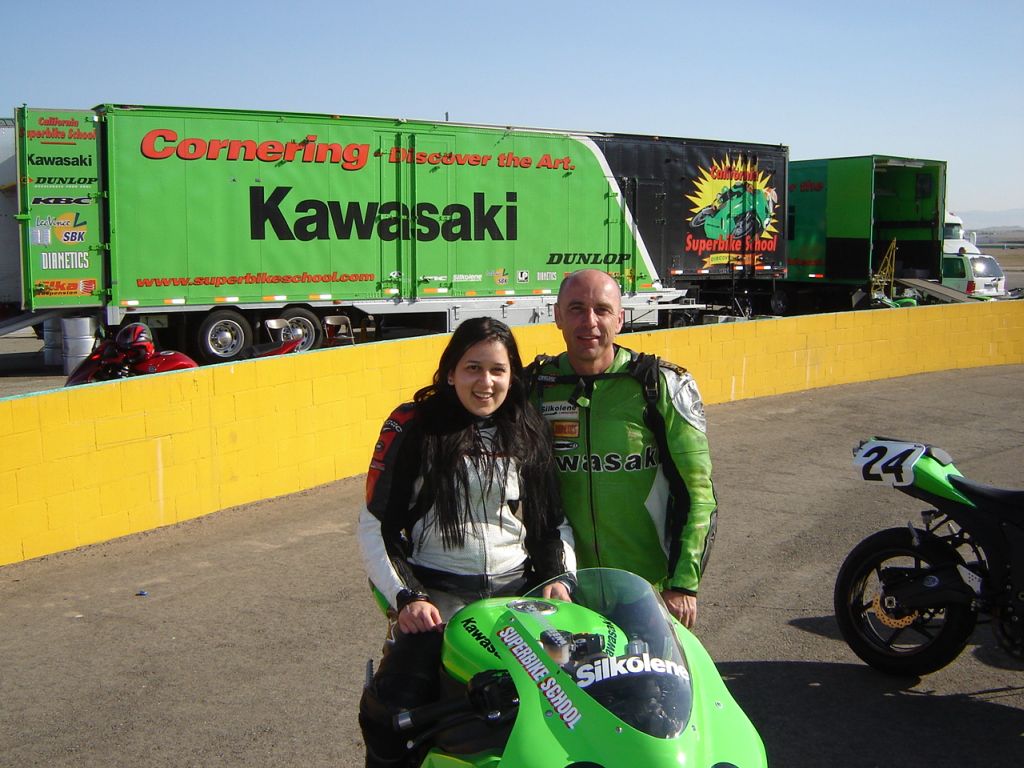
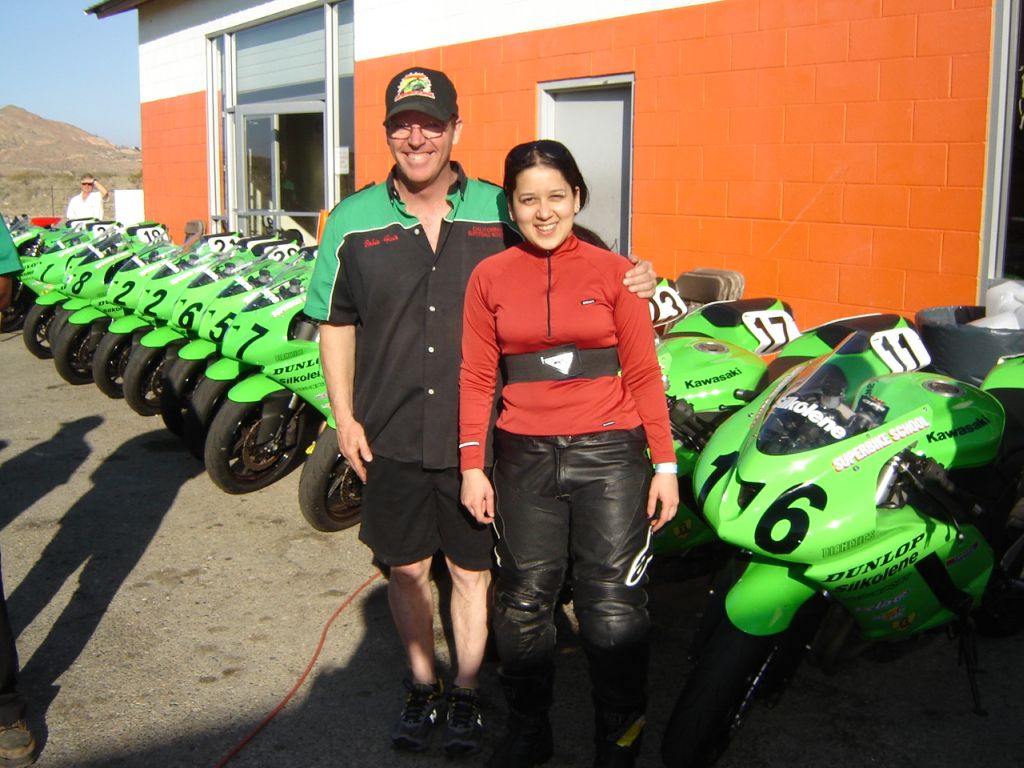
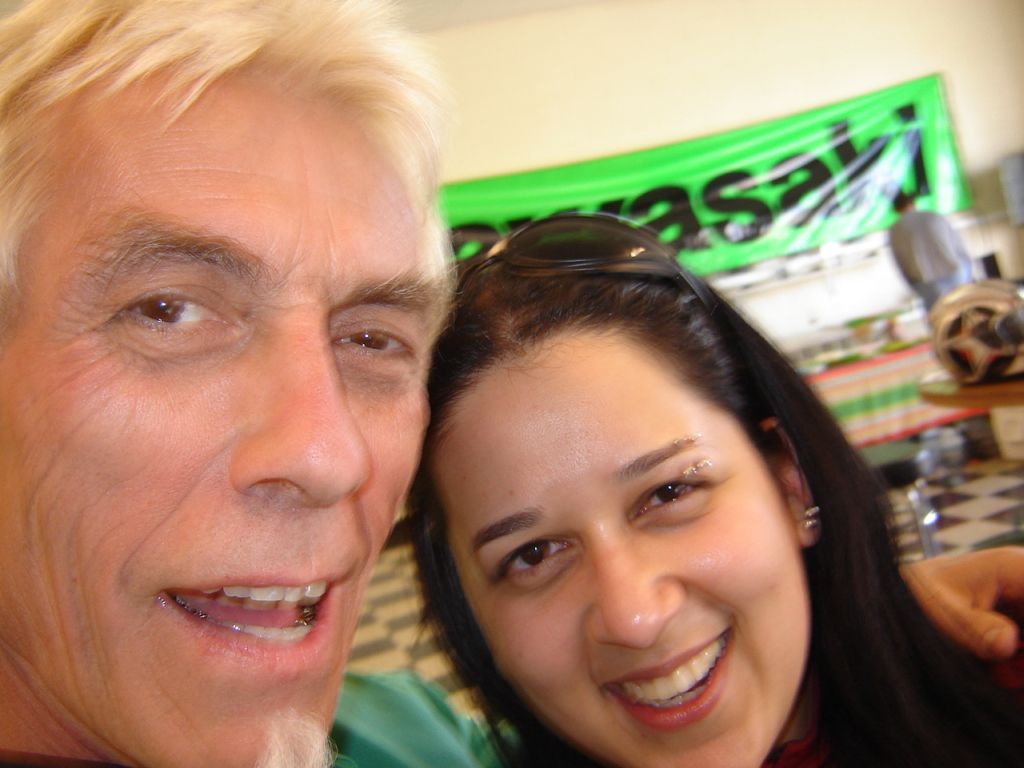
I never wanted to leave. I wanted to live there on the track, and ride everyday, practicing, perfecting, getting better, really, really living. Everything seemed so slow now, so mundane, so anti-climactic. I wanted to always be with these people, whose life is riding, who do it so well, whom I could talk to all day long, and have that sense of camaraderie and kinship that all true bikers share.
I knew then that I’d come back for Levels III and IV.
GOING HOME
I’ll skip over the dull details of the return journey. Suffice to say that I woke up at 4:30 the next morning, drove back to Burbank, dropped off my rental car, made my 8:10 flight and flew back home to Seattle. Coming home is always good, but a little bitter-sweet. My mind was a whirlwind of thoughts, I kept going over the past two days, making copious notes about all the things I had learned about my riding, what I needed to do to improve and how, what I would do over the next year, and how I was finally not afraid of the unexpected any more.
FINAL NOTES
Lap Times: I found the reported lap times a bit confusing.
Day 1: Maximum Lap Time: 09:47:90, Minimum Lap Time: 03:06:99
Day 2: Maximum Lap Time: 11:20:55, Minimum Lap Time: 00:08:98
The maximum lap times are probably that long to account for some of the times I got pulled off the track by the coach to chat. I’m not quite sure how to account for the minimum times because 00:08:98 does not sound like a reasonable amount of time to have gone around the entire track. Looking at the numbers, I think I averaged about 3.5 minutes the first day and 2.30 seconds the second day.
Things that I need to consciously work on and improve:
Throttle Control – get smoother, roll on throttle confidently and hold it, don’t make adjustments through the turn (get a good entry point to avoid having to make adjustments mid-turn)
Fixating on edges of track – I did this a lot when the turn points for close to the edge. I need to keep in mind that once my bike was pointed towards the turn point and I knew I was going to make it and was a couple of bike lengths away from it, I need to drag my gaze towards the next turn to avoid fixating on the track edge.
Reference Points – I didn’t do this drill very well, and it is probably only useful on the track or streets that I ride a lot, but I need to start picking out and memorizing reference points and use them as cues.
Other Riders – I am still very wary about having other riders in my path, either ahead of me or passing me. And I am not at all confident about passing. If someone overtakes me, I completely lose my line and fumble. This is something I really need to work on.
Gripping with knees – I need to ride the SV correctly and grip the tank more.
Not trusting tires – This is my constant, irrational fear. What if my tires suddenly lose grip or do something unexpected? I understand that tread depth isn’t the only good indication of a reliable tire.
Dry contacts/blurred vision: My contacts drying out because of the wind and not enough blinking was a real problem on the track, especially in the dryness of the desert. More than once, I had blurred vision because of my eyes tearing up too. I’m not quite sure what to do about this. I contemplated wearing glasses for a couple of laps, but it didn’t seem like a good option. And I definitely do not want to get surgery.
Dirty Visor: Sounds stupid, but this was the reason for fouling up quite a few turns. As Murphy’s Law would have it, insects would get splattered exactly over my left eyeball. And I’d kick myself for forgetting to clean my visor when I pitted. This was another reason for messing up on the video bike btw. I literally couldn’t see clearly sometimes, and you can see me trying to scrub the insect remains away in the initial sections of the video.
Body positioning: Practice proper body positioning so that I am not hanging on to the bars.
Thoughts on the ZX-6R: Having never ridden on a super sport bike, once I stopped fighting the bike, I was blown away by the suspension, acceleration and braking system on the ZX-6R.I couldn’t believe how comfortable I was on the straights when I really broke open the throttle, how wonderfully it handled the corners, and how easily I could move around on the seat. My SV feels like a sluggish, fat hog in comparison. :(
I need to book myself for a few track days at PR this year and practice my newly learned skills. I will practice them on the street too of course, but I wouldn’t feel safe going all out and getting more aggressive unless I were in a controlled environment.
Things I need to do on the SV to make it work better on the track:
– Get a new windshield/front fairing setup to make it handle better at higher speeds. As of now, I feel like I’m getting blown off of the bike when I open the throttle on the straights.
– Braided steel brake lines
– Get rid of the handlebar risers
– New rear shock – I just got the front forks done and it’s already handling a lot better, and I know that getting a good quality shock will make a world of difference.
– New tires – these ones should probably be replaced before a track day. I might go in for Michelin Pilot Powers, assuming there is no more recall on them. I also have a standing deal to get a set of Dunlop qualifiers at $200 from the school should I want them.
Oh, and I’ll be getting a diskfull of photos in the mail in about three weeks, which I’ll post later. Hopefully there is at least one good picture on there for me to remember the camp by.





